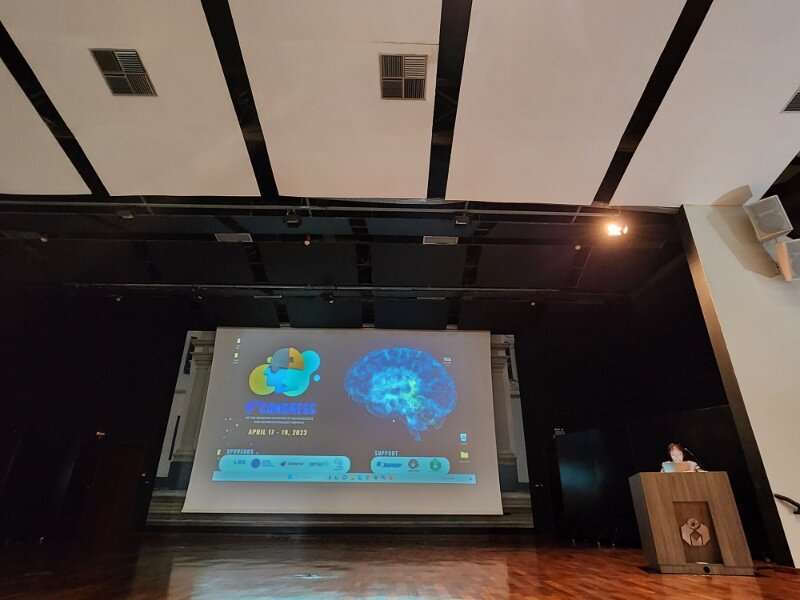This article has been reviewed according to Science X's editorial process and policies. Editors have highlighted the following attributes while ensuring the content's credibility:
fact-checked
peer-reviewed publication
trusted source
proofread
Even mild COVID-19 can cause structural and functional alterations in the brain, say studies

Even mild COVID-19 can cause structural and functional alterations in the brain that may lead to neuropsychiatric disorders, such as anxiety, depression, fatigue and somnolence, as well as adverse effects on well-being, health and work capacity.
This is the conclusion of studies on COVID-19 presented at the 9th BRAINN Congress organized by the Brazilian Institute of Neuroscience and Neurotechnology (BRAINN), a Research, Innovation and Dissemination Center (RIDC), held April 17–19 in São Paulo, Brazil.
"Before the pandemic, Brazil was already considered one of the most anxious countries in the world, with 9% of the population reporting symptoms. Now we find higher levels of anxiety and depression in people who test positive for COVID-19," said Clarissa Yasuda, a professor at UNICAMP's Medical School (FCM) and a researcher affiliated with BRAINN.
One of the presentations at the conference reported the findings of an analysis of MRI scans performed three months after infection and showing gray matter atrophy and cerebral hyperconnectivity in patients with long COVID.
The duration of these alterations and their significance from the biological standpoint are unknown, but the results suggest cognitive dysfunction, which the scientific literature shows to be highly affected by anxiety and depression, according to an article on the study published in a special supplement of the journal Neurology by Beatriz Amorim da Costa, an undergraduate at FCM-UNICAMP, and collaborators.
"Our findings serve as an alert to the extent of the pandemic's possible consequences," said Yasuda, last author of the article.
Gray matter atrophy appeared in MRI scans of the brains of patients infected by four different strains of SARS-CoV-2 (alpha, delta, gamma and zeta), according to Lucas Scárdua Silva in another article published in the same issue of Neurology. This study, which Yasuda also supervised, detected frontal lobe and limbic system gray matter atrophy in subjects infected by all four strains.
Ítalo Karmann Aventurato presented the results of a study showing verbal memory impairment in patients infected by all four strains. The study was also led by Yasuda and reported in the same journal.
Economic impact
The impact of long COVID on work capacity was the focus of a presentation by Gabriel Monteiro Salvador, who had a scientific initiation scholarship from FAPESP. Persistent neuropsychiatric symptoms such as somnolence, fatigue, anxiety and depression correlated directly with impaired work capacity in COVID-19 survivors, he said. The study, also overseen by Yasuda, is available in the same issue of Neurology.
Initially, a group of bank workers with similar characteristics in terms of job description, routine and schooling answered a questionnaire called the Work Ability Index (WAI), designed to arrive at an assessment of problems relating mainly to memory and cognition. In a follow-up assessment some months later, 62.5% of the participants still had reduced WAI scores.
"The economic impact of these people's health problems is evident, underscoring the urgent need for specific treatment to reduce the loss to both the individuals concerned and society as a whole," Salvador said.
Quantifying fatigue in practice
Fatigue is one of the symptoms most frequently reported by patients with long COVID, but the term is typically generic and lacks a clear definition. To quantify fatigue, researchers at UNICAMP's Center for Biomedical Engineering (CEB) led by Leonardo Elias, a professor at the School of Electrical and Computer Engineering (FEEC-UNICAMP), developed a set of tests to measure muscle contraction and force, neuromuscular function, hand muscle fatigability and manual dexterity.
The participants in the experiment were asked to perform a number of tasks, during which index finger abduction force and first interosseous dorsal muscle contraction force were measured with sensors and electromyography, a technique for recording the electrical activity produced by skeletal muscles. They were also submitted to the Nine Hole Peg Test, a standardized assessment used to measure finger dexterity.
Despite limitations such as the small number of participants and the possible influence of anxiety and depression symptoms, the study showed that motor skills may be impaired in patients with symptoms of fatigue due to long COVID. For example, motor unit force-frequency relationships were abnormal in reaction tasks, although reaction time was preserved. In the Nine Hole Peg Test, the patients underperformed with the dominant hand compared with the control group.
"The possible explanations for these results include increased intercortical inhibition [a neurophysiological process in which the activity of neurons in the cortex is reduced] and GABAergic pathway dysfunction [impairing regulation of cognitive and emotional processing], alterations in executive functions [cognitive skills relating to control of actions, emotions and thoughts] and greater perceived fatigue," Elias said.
More information: Beatriz Amorim Da Costa et al, Anxiety And Depression Are Associated With Limbic Atrophy And Severe Disruption Of Brain Functional Connectivity After Mild COVID-19 Infection (S21.007), Neurology (2023). DOI: 10.1212/WNL.0000000000202252
Lucas Silva et al, The MRI Analysis of 300 Subjects Revealed Grey Matter Atrophy of the Frontal Lobe and Limbic System in Four SARS-CoV-2 Strains (S21.004), Neurology (2023). DOI: 10.1212/WNL.0000000000202800
Ítalo Karmann Aventurato et al, Long-COVID-19 cognitive disfunction: strain-specific effects on 452 subjects (S21.010), Neurology (2023). DOI: 10.1212/WNL.0000000000202389
Gabriel Salvador et al, The Analysis of 607 Volunteers Shows a Reduction of Workability in Individuals With LONG-COVID Syndrome Associated With Neuropsychiatric Symptoms (P5-10.004), Neurology (2023). DOI: 10.1212/WNL.0000000000202309



















